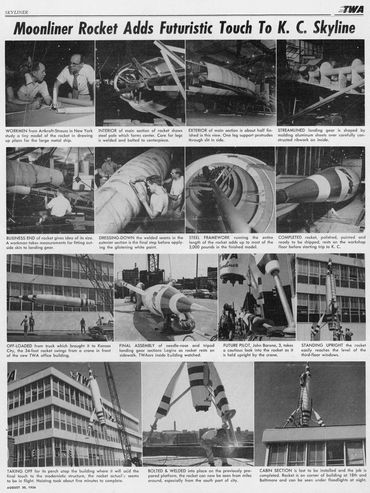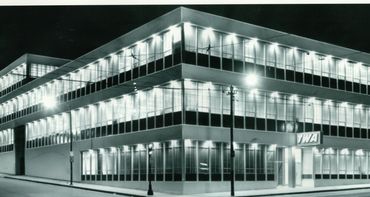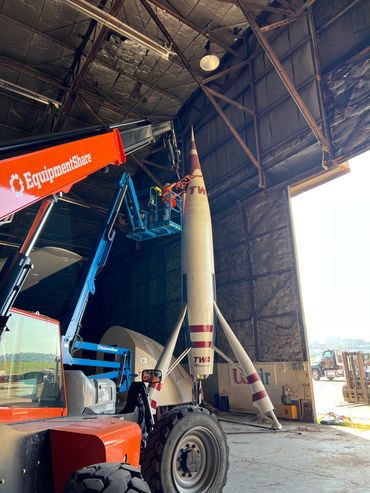Moonliner II

TWA Moonliner II
Date Acquired: September 27, 2025
On Loan from Dan Viets, Columbia, Missouri
The following is a brief history of the Moonliner.
TWA Moonliner I
From 1955 through 1962, the TWA Moonliner was part Disneyland's Tomorrowland in Anaheim, California. Tomorrowland is one of the five "themed lands" featured at the original Disney theme park. Tomorrowland's centerpiece was the TWA Moonliner, influenced by Disney's "Man in Space" television episodes developed in the 1950s. At 76-feet tall, the Moonliner was the tallest structure in the park, even taller than the park’s iconic Sleeping Beauty Castle. Even at this enormous scale, the rocket was still only a roughly one-third scale replica of the envisioned 200+ foot Moonliner. The Moonliner symbolized the “Rocket to the Moon” attraction, which was a simulated ride around the Moon and back to Disneyland.
TWA celebrated its 30th year of service in 1955. It partnered with Walt Disney, famous rocket scientist Wernher von Braun, and TWA's Howard Hughes to design the Moonliner passenger rocket concept. This partnership was also an early example of product placement advertising by Hughes’ TWA Airline teaming up with Disney as the Moonliner's sponsor.
Designed by John Hench, one of the original Disney Imagineers, with the help of von Braun, the Moonliner depicted what a commercial space liner might look like traveling to the Moon in the faraway year of 1986. The landing gear that would have been retracted into the lower sides of the Moonliner after takeoff were said to resemble the sleek lines of the Lockheed Constellation. The propulsion would have come from an on-board atomic reactor, ensuring that the Moonliner would have a “safe and steady” power supply for the trip.
The Moonliner was near the entrance to Disney’s “Rocket to the Moon” attraction presented by TWA, which gave visitors a taste of what it might be like to take a ride around the Moon and back. The ride featured a round room with concentric circles of seats and two round screens at the top and bottom of the circular theater. The bottom screen showed visitors the Earth as they blasted off and the top one showed the Moon as it grew ever larger during their trip toward it. In later years, this would become the “Flight to the Moon” presented by McDonnell Douglas and later still, “Mission to Mars”.
TWA ended its corporate sponsorship of the “Rocket to the Moon” ride at Disneyland in 1961. The Douglas Aircraft Company stepped in and took over the sponsorship in 1962. Now that TWA was no longer a sponsor, the rocket was repainted with a new color scheme. The white body remained, but the TWA stripes were removed. A blue vertical stripe was added which ran the length of the body with the name “Douglas” highlighted from top to bottom. This color scheme remained until 1967. At that time, the Moonliner was dismantled from Tomorrowland and moved to an on-site “boneyard” where it was last seen in 1981.

TWA Moonliner II
In 1956, Hughes had a 32.5-foot-tall scale model of the Disneyland Moonliner, known as the Moonliner II, built in New York City, placed on the southwest corner roof location of TWA's then-new office building at 1735 Baltimore in Kansas City. It remained there until 1961, when the partnership with Disney ended and it was removed. It was sold in 1962 to Space Craft, an Independence, Missouri manufacturer of travel trailers and RV units. The Moonliner and Space Craft later moved to Concordia and the rocket was placed near the south side of I-70 between St. Louis and Kansas City at the Space Craft assembly plant.
The Moonliner II spent the next 25 years outside, unprotected from the harsh weather conditions, with minimal maintenance. Dan Viets, a Columbia, Missouri attorney who is a Disney historian and author, purchased the Moonliner II in 1997. Dan, along with Don Jourdan, then began a long, careful restoration process, eventually bringing the rocket back to its 1956 condition and sporting its original red and white TWA paint scheme. The Moonliner II was loaned to the Airline History Museum at the Charles B. Wheeler Downtown Airport – Wheeler Field in about 2005. On September 27, 2025, the rocket was relocated and loaned to the TWA Museum at 10 Richards Road where it can be seen inside Hangar 1 for museum guests to appreciate.
Moonliner II at TWA's then-new office building at 1735 Baltimore in Kansas City






Moonliner II at Space Craft



Landing Day at the TWA Museum! September 27, 2025















TWA Moonliner III
Although the original 76-foot-tall Moonliner has been removed from Tomorrowland, a replica of the original Moonliner was installed in Tomorrowland again in 1998 by imagineer Bruce Gordon, Tony Baxter, Doug Mumford and others. Sporting its original bright red TWA colors against its sleek white fuselage it was sponsored Coca-Cola. Although the rocket no longer carries its TWA markings, it still stands in Disneyland today. It is roughly the same height as Kansas City’s Moonliner II.

TWA Moonliner IV
In early 2005, the Nicholson Group, a Kansas City, Missouri urban development firm, acquired the former TWA headquarters building. In order to obtain Historic Tax Credits from the state of Missouri, they needed to return the building to its original appearance. Dan Viets declined to sell the original Moonliner to them because he feared it would deteriorate again when left out in the elements. Therefore the Nicholson Group hired local architectural firm, El Dorado Inc., to design and oversee the historic restoration of the TWA corporate headquarters building, complete with a replica of the Moonliner II. The Bratton Corporation was contracted in early 2006 to fabricate a brand new TWA Moonliner II replica for the building's roof. This new, fully illuminated rocket was completed and then installed on September 29 of that year at the very same southwest corner roof location as the original Moonliner II. The TWA building was then leased to Kansas City-based advertising agency Barkley, Inc. The agency moved in on November 14, 2006. The area surrounding the TWA building is known as Kansas City's Crossroads Arts District.

TWA’s Cosmic Contest
The Cosmic Contest was one of the features of TWA's celebration of its 30th year of service in 1955. It consisted of two parts, the first of which offered a prize of $50,000 (representing 18 states in the U.S., plus Canada, England, India and Switzerland) for the best 30-word statement on the merits of air travel. The contest was compelling enough to attract several luminaries as judges, among-them Walt Disney and Jacqueline Cochran.
To launch the contest in 1955, TWA arranged a symposium on the future of commercial aviation by leading aeronautical and astronautical scientists at the American Museum of Natural History/Hayden Planetarium in New York. Participants then included Dr. Wernher von Braun, chief of the Guided Missile Development Division at the U.S. Army's Red Stone Arsenal; Dr. Fred L. Whipple, Chairman of the Department of Astronomy at Harvard University; and Hall Hibbard, vice president of engineering at Lockheed Aircraft Corporation.
The experts' predictions ranged from planes powered by nuclear energy to helicopter house-trailers. While some participants saw the jet engine as the principal means of propulsion in 1985, others anticipated the introduction of atomic power, driving enormous planes accommodating passengers in the wings rather than in the fuselage. For shorter range service they foresaw the use of vertical-rising aircraft, as well as turbo-propeller cargo planes as the means of transporting all mail and parcel post.
The second part of the Cosmic Contest offered entrants a chance to forecast the future of commercial aviation. They were asked to describe, in 200 words or less, what commercial air travel might be like in 1985, and to submit an optional sketch of the type of aircraft that might be used. Vying for a $50,000 grand prize (and trip prizes to runners-up), to be awarded 30 years later, 13,000 contestants submitted entries. They represented nearly all the states in the U.S., and many parts of the world including Canada, Europe, the Middle East and South America.
The predictions entered by contestants in the Cosmic Contest were no less visionary. Many contestants thought air travel speeds of 1,000 to 2,000 miles an hour would be commonplace in 1985, while others imagined sub-orbital speeds in excess of 25,000 miles per hour, making possible interhemispherical weekends with a home in one part of the world and an office in another. Some saw the airliner of the future as a rocket-propelled "space hotel", or a two-toned double-decker, transparent for sightseeing, equipped with two-way TV, radio and telephone facilities in addition to a swimming pool, barber shop, beauty parlor, children's playroom and restaurants.
Concerned with passenger comfort and convenience, entrants suggested such developments as: food capsules replacing meals; adjustment to changes in air pressure by a hormone capsule called "atoton"; telescopic lenses in floor windows; and advancements that would make aircraft "germ proof, sound proof, and wreck proof." One contestant proposed a flying saucer design.
The entries were microfilmed and stored carefully in a vault inside the Moonliner II on the roof of TWA's then-new office building at 1735 Baltimore in Kansas City. When TWA later relocated, the entries were placed in a bank safe deposit box. The microfilmed entries ultimately landed with the University of Missouri - St. Louis/Transportation Collections at the St. Louis Mercantile Library as part of a collection that was donated to them back in 2001 by TWA as it was winding down independent operations. That collection consisted of several hundred film reels and video cassettes. In September of 2025, the St. Louis Mercantile Library arranged for a long-term loan of the collection to our Museum. We were pleasantly surprised to discover the Cosmic Contest microfilmed entries to be included within the loaned collection!
Thirty years is a long time to wait to find out if you've won a contest. But that's exactly what 13,000 contestants in TWA's Cosmic Contest had done. In 1955, they were asked to forecast what commercial aviation would be like in 1985. So, in 1986, the time arrived to choose the most accurate prediction. A panel of expert judges including astronaut Charles (Pete) Conrad, aviation author Robert Serling (brother of Twilight Zone creator Rod Sterling), and then TWA president Richard Pearson chose four winners (the winners' heirs were also entitled to the prize.)






The TWA Museum at 10 Richards Road
This website uses cookies.
We use cookies to analyze website traffic and optimize your website experience. By accepting our use of cookies, your data will be aggregated with all other user data.